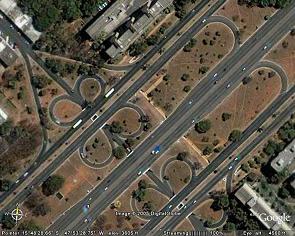Facts
Travel
Hotels
Restaurants
Business
Photos
|
Transportation in Brasília
 Brasilia Brasilia
 Brasilia Facts Brasilia Facts
Brasília was planned to be a city where transit flows smoothly. Lucio Costa planned the streets in such a way that even traffic lights would not be necessary: cars and buses would take thoroughfares to displace long distances, then would use one of several loops to gain access to local streets to reach specific destinations.
Much of the original planning had to be changed, mostly because of the growth of Brasília. Lúcio Costa didn't foresee such a quick growth in the Pilot Plan, much less the explosive growth in the Satellite cities. Brasília today has traffic lights as any other city; there is a scarcity of parking places; traffic jam is usual at peak hours, particularly in some busier loops.
However, even though the present situation is not as planned by Costa, transit in Brasília is still much better than in other major Brazilian cities. There is a stricter enforcement of the law, which results in better educated drivers (Brasília is one of the few cities in Brazil where drivers stop in a cross walking). The streets are usually in good shape, which minimizes accidents.
 Still, the main reason for Brasilia having a better transit is Lucio Costa's plan; vehicles still make use of the system of thoroufares, loops and local streets to reach their destinations.
Still, the main reason for Brasilia having a better transit is Lucio Costa's plan; vehicles still make use of the system of thoroufares, loops and local streets to reach their destinations.
The main thoroughfare is the Eixão (Eixo Rodoviário, in Costa's Plan). It is a high speed highway which cuts Brasilia from North to South, three lanes each way; except for a few spots in the central area, there are no traffic lights in the Eixão. Parallel to the Eixão, there are two Eixinhos (small Axis), which facilitates the access to loops and eventually to local streets. The image to the left shows the Eixão, the Eixinhos and loops heading to local Commercial blocks.
The other major thoroughfare is the Monumental Axis, which cuts the Pilot Plan from East to West. The Monumental is wider and busier than the Eixão; there are a few traffic lights along the Monumental.
The other two important avenues of the Pilot Plan are the W3, which runs west of the Eixão, parallel to it, and L2, which runs east of the Eixão. Most bus lines going from North to South use W3 and L2, rather than the Eixão (vehicles are not allowed to stop along the Eixão).
Read more about public transportation in Brasilia: buses, taxis, the metro.
|
|

